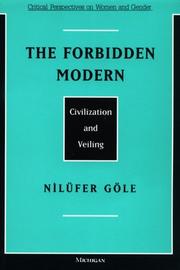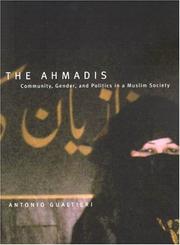| Listing 1 - 10 of 43 | << page >> |
Sort by
|
Book
Year: 1972 Publisher: Peshawar : Nashiran-e-Ilm-o-Taraqiyet,
Abstract | Keywords | Export | Availability | Bookmark
 Loading...
Loading...Choose an application
- Reference Manager
- EndNote
- RefWorks (Direct export to RefWorks)
Muslim women. --- Polygamy. --- Purdah.
Book
ISBN: 9782705673116 Year: 2013 Publisher: Paris : Hermann,
Abstract | Keywords | Export | Availability | Bookmark
 Loading...
Loading...Choose an application
- Reference Manager
- EndNote
- RefWorks (Direct export to RefWorks)
A partir d'une enquête menée auprès de jeunes Tunisiennes, cet ouvrage donne la parole aux premières concernées et montre les diverses significations que peut prendre la décision de porter le voile dans des sociétés fortement imprégnées par le patriarcat.
Purdah --- Muslim women --- Muslim youth --- Purdah --- Musulmanes --- Jeunesse musulmane
Book
ISBN: 9782234081864 2234081866 Year: 2017 Publisher: Paris: Stock,
Abstract | Keywords | Export | Availability | Bookmark
 Loading...
Loading...Choose an application
- Reference Manager
- EndNote
- RefWorks (Direct export to RefWorks)
Women in Islam --- Purdah --- Women's rights --- Feminism --- Islam --- Muslims --- Imams (Mosque officers) --- Oubrou, Tareq, - 1959-
Book
Year: 1997 Publisher: Kuala Lumpur : Islamic Book Trust,
Abstract | Keywords | Export | Availability | Bookmark
 Loading...
Loading...Choose an application
- Reference Manager
- EndNote
- RefWorks (Direct export to RefWorks)
Clothing and dress --- Clothing and dress --- Muslim women --- Muslim women --- Muslim women --- Purdah. --- Purdah. --- Religious aspects --- Islam. --- Religious aspects --- Islam. --- Religious aspects --- Islam. --- Social life and customs. --- Social life and customs.

ISBN: 0862329558 086232954X Year: 1990 Publisher: London Atlantic Highlands, N.J., USA Zed Books
Abstract | Keywords | Export | Availability | Bookmark
 Loading...
Loading...Choose an application
- Reference Manager
- EndNote
- RefWorks (Direct export to RefWorks)
Islam --- Sociology of the family. Sociology of sexuality --- India --- Purdah --- 849 Gender --- 845 Religie --- 883.5 Zuid-Azië --- Feminism --- Muslim women --- Social conditions. --- Social conditions --- Women, Muslim - India - Social conditions. --- Feminism - India. --- Purdah. --- Gender apartheid --- Hijab (Seclusion) --- Pardah --- Purda --- Sexual apartheid --- Segregation --- Women --- Burqas (Islamic clothing) --- Hijab (Islamic clothing)

ISBN: 0472066307 Year: 1996 Volume: *5 Publisher: Ann Arbor The University of Michigan Press
Abstract | Keywords | Export | Availability | Bookmark
 Loading...
Loading...Choose an application
- Reference Manager
- EndNote
- RefWorks (Direct export to RefWorks)
Women --- -Muslim women --- -Women in Islam --- -Purdah --- -Veils --- -Headgear --- Hijab (Islamic clothing) --- Gender apartheid --- Hijab (Seclusion) --- Pardah --- Purda --- Sexual apartheid --- Segregation --- Burqas (Islamic clothing) --- Islam --- Islamic women --- Women, Muslim --- Human females --- Wimmin --- Woman --- Womon --- Womyn --- Females --- Human beings --- Femininity --- Social conditions --- -Social conditions --- -Gender apartheid --- Sociology of culture --- Religious studies --- Turkey --- Muslim women --- Women in Islam --- Purdah --- Veils --- Religious fundamentalism --- Norms --- Book --- Veil
Book
ISBN: 9780415565509 0415565502 9780203117590 9781136304545 9781136304583 9781136304590 9780415533362 0415533368 Year: 2012 Publisher: Milton Park, Abingdon, Oxon ; New York, NY : Routledge,
Abstract | Keywords | Export | Availability | Bookmark
 Loading...
Loading...Choose an application
- Reference Manager
- EndNote
- RefWorks (Direct export to RefWorks)
Islamic veiling in legal discourse looks at relevant law and related discourses in order to examine the assumptions and limits of the debates around the issue of Islamic veiling, which has become so topical in recent years. For some, Islamic veiling indicates a lack of autonomy, the oppression of women and the threat of Islamic radicalism to western secular values. For others, it suggests a positive autonomous choice, a new kind of gender equality and a legitimate exercise of one's freedom of religion, a treasured right in democratic societies--Back cover.
Hijab (Islamic clothing). --- Purdah. --- Veils --- Muslim women --- Clothing and dress --- Sex discrimination. --- Religious aspects --- Islam. --- Clothing. --- Conduct of life. --- Hijab (Islamic clothing) --- Purdah --- Sex discrimination --- Islam --- Clothing --- Conduct of life --- Veils - Religious aspects - Islam --- Muslim women - Clothing --- Muslim women - Conduct of life --- Clothing and dress - Religious aspects - Islam
Book
ISBN: 0813026075 9780813026077 Year: 2001 Publisher: Gainesville University Press of Florida
Abstract | Keywords | Export | Availability | Bookmark
 Loading...
Loading...Choose an application
- Reference Manager
- EndNote
- RefWorks (Direct export to RefWorks)
Illustrated with photographs, drawings, and cartoons gathered from popular culture, this provocative book demonstrates that the veil, the garment known in Islamic cultures as the hijab, holds within its folds a semantic versatility that goes far beyond current clichés and homogenous representations. Whether seen as erotic or romantic, a symbol of oppression or a sign of piety, modesty, or purity, the veil carries thousands of years of religious, sexual, social, and political significance. Using examples from both the East and West--including Persian poetry, American erotica, Iranian and Indian films, and government-sanctioned posters--Faegheh Shirazi shows that the veil has become a ubiquitous symbol, utilized as a profitable marketing tool for diverse enterprises, from Penthouse magazine to Saudi advertising companies. She argues that perceptions of the veil change with the cultural context of its use as well as over time: in a Hindi movie the veil draws in the male gaze, in an Iranian movie it denies it; photographs of veiled women in Playboy aim to titillate a principally male audience, while cartoons of veiled women in the same magazine mock and ridicule Muslim society. Shirazi concludes that the practice of veiling, encompassing an amazingly rich array of meanings, has often become a screen upon which different people in different cultures project their dreams and nightmares. --provided by publisher.
Veils --- Muslim women --- Costume --- Muslim women in art. --- Purdah. --- Purdah in literature. --- Hijab (Islamic clothing) --- Clothing and dress --- Erotica --- Head scarves, Islamic --- Head scarves, Muslim --- Headscarves, Islamic --- Headscarves, Muslim --- Islamic head scarves --- Islamic headscarves --- Islamic scarves --- Muslim head scarves --- Muslim headscarves --- Muslim scarves --- Scarves, Islamic --- Scarves, Muslim --- Islamic clothing and dress --- Burqas (Islamic clothing) --- Kerchiefs --- Purdah --- Gender apartheid --- Hijab (Seclusion) --- Pardah --- Purda --- Sexual apartheid --- Segregation --- Women --- Fancy dress --- Motion pictures --- Opera --- Stage costume --- Theater --- Theatrical costume --- Decorative arts --- Islamic women --- Women, Muslim --- Headgear --- Social aspects. --- Costume. --- Erotic aspects. --- Clothing --- Social conditions --- Muslimahs

ISBN: 1282861964 9786612861963 0773572058 0773527370 9780773527379 0773527389 9780773527386 9780773572058 9781282861961 6612861967 Year: 2004 Publisher: Montreal, Que. McGill-Queen's University Press
Abstract | Keywords | Export | Availability | Bookmark
 Loading...
Loading...Choose an application
- Reference Manager
- EndNote
- RefWorks (Direct export to RefWorks)
Dedicated to supernatural revelation and the divine governance of society, Pakistan's Ahmadi community has endured mob violence and penal sanctions for refusing to embrace the beliefs of the Sunni majority. They disagree with fundamentalist ideas of exclusiveness and consider themselves a reformed version of Islam. Although they have adopted Enlightenment ideas about the pursuit of scientific knowledge and produced a notable number of technicians, doctors, and scientists, women continue to live under a strict definition of purdah and the community remains conservative. The Ahmadis reveals a society strictly grounded in divinely prescribed patterns - including parental authority, close family ties, a disposition towards gender-specific roles, and separation of the sexes - but at odds with fanatical Muslim fundamentalism, whose wrath has spread beyond the Ahmadi minority to include the West.
Ahmadiyya members --- Ahmadiyya. --- Aḥmedīya --- Qadiani --- Qadiyani --- Islamic sects --- Ahmadiyya --- tradition and modernity --- community --- piety and religious life in Rabwah --- social life and institutions --- Purdah and vocation --- politics --- Islam --- the Ahmadis --- harassment and persecution --- gender --- Muslim society
Book
ISBN: 2355960100 6167571155 Year: 2018 Publisher: Bangkok : Institut de recherche sur l’Asie du Sud-Est contemporaine,
Abstract | Keywords | Export | Availability | Bookmark
 Loading...
Loading...Choose an application
- Reference Manager
- EndNote
- RefWorks (Direct export to RefWorks)
This study will focus on the Indonesian jilbab, an ubiquitous piece of cloth that covers the hair and neck of women tightly, leaving no skin unconcealed. Achievement and role of jilbab after the authoritarian regime of Soeharto in 1998 is hardly known. The author examines women perception but also the Sharia Ordinances and the narratives of censorship. Voices of both women and sexual minorities (transgenders, gays, lesbians, bisexuals and queers) finally demonstrate awareness of the politics of representation in contemporary Indonesia, highlighting the links between religion, politics and identity.
Hijab (Islamic clothing) --- Muslim women --- Clothing --- Islamic women --- Women, Muslim --- Women --- Head scarves, Islamic --- Head scarves, Muslim --- Headscarves, Islamic --- Headscarves, Muslim --- Islamic head scarves --- Islamic headscarves --- Islamic scarves --- Muslim head scarves --- Muslim headscarves --- Muslim scarves --- Scarves, Islamic --- Scarves, Muslim --- Islamic clothing and dress --- Burqas (Islamic clothing) --- Kerchiefs --- Purdah --- Veils --- politics --- Civil Society --- gender --- sexuality --- rights --- freedoms --- democracy --- Indonesia --- Muslimahs
| Listing 1 - 10 of 43 | << page >> |
Sort by
|

 Search
Search Feedback
Feedback About UniCat
About UniCat  Help
Help News
News